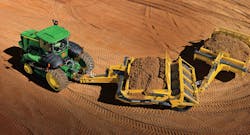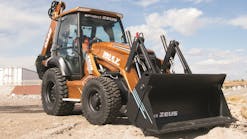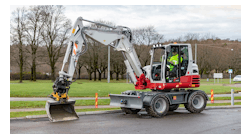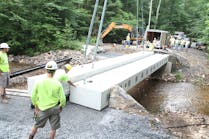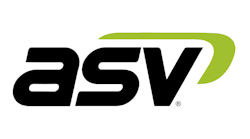Because skilled operators are more difficult than ever to attract and retain, contractors want machines that are easy to operate and comfortable to spend time in. And manufacturers are delivering just such machines. With today’s easy-to-run dozers, an operator can focus more on the work at hand and less on adjusting the machine-and deliver more work in the process. In fact, dozer controls can allow an inexperienced operator to produce at an acceptable level and can improve the productivity of even the most experienced operator. Case’s H Series Last year Case Construction Equipment introduced its H series of dozers. The company makes five models of smaller dozers, which range from the 550H with 67 hp to the 1150H with 119 hp. The H series features full four-speed power-shift transmission, points out Rusty Schaefer, marketing manager for Case. The operator can shift among all four speeds on two levers. The two levers control left and right track speed, respectively. On the left-hand console is a forward/reverse selector configured as either a U-pattern or a straight pattern. Case basically moved speed-range shifting from a foot pedal to a button on the left-hand control lever. With both levers back, the dozer is in low gear, low range; if you touch the button once, you’ll go to second gear. To go to third, you push both levers forward and hit the button again. To shift into fourth gear, you push the button yet again. “You used to have to stop and shift a pedal to change range speeds,” recalls Schaefer. “Now the button shifts ranges for you.” There is no variance in speed by the amount you move the levers. The dozer has a torque converter drive with power-shift ability and power-turn ability. “You can shift from forward to reverse with a wide-open throttle and get a smooth transition,” he explains.For power turns, Schaefer says the Case dozer can put 100% of the machine’s power to either track. That is why it performs better than a dozer with hydrostatic transmission, he adds, which puts roughly half the dozer’s power to either track-and will either spin out or stall under heavy load.With Case’s power-shift arrangement, each track effectively has a two-speed transmission. By putting one track in high gear and the other in low gear, you can achieve a power turn. Schaefer says the full four-speed power-shift transmission is new on the 650H, 750H, and 850H. Case lowered the efforts on the hydraulic control lever: There is one lever for controlling all six-way movements of the blade, Schaefer points out. “The general direction of controls is toward lower efforts and shorter throws for easier operation. The whole name of the game is to make it easier for operators to control the machine.” Schaefer says Case also introduced new styling, operator comfort features, and improved visibility with the H series. And the company brought out three versions-long tracks, wide tracks, and low ground pressure (LGP) models-for all five basic sizes of dozers. Prior to the H series, Case offered long-track and LGP machines but didn’t sell a wide-track dozer, states Schaefer. Wide tracks, he says, are more stable for working slopes, and the undercarriage cleans out better because there’s more room for dirt to fall between the tractor and the undercarriage.Cat’s and Deere’s Hydrostatic Models
The Variable Pitch Power Angle Tilt blade helps you match pitch to material conditions for optimum penetration, carry volume, and shedding capabilities.Caterpillar markets four models with less than 130 hp: the D3C Series III Hystat, D4C Series III Hystat, D5C Series III Hystat, and D5M. Those models have horsepower ratings of 70, 80, 90, and 110, respectively. A hydrostatic power train gives the Hystat models full power-turn capability, a stepless speed range, dynamic braking, and smoother modulation for steering and directional shifts. Caterpillar has discontinued its clutch-and-brake models in the D3C Series III, D4C Series III, and D5C Series III dozers. A single joystick on the Hystat models controls speed, direction, and steering so that operator effort is minimal. For high productivity, full power turns can be made by maintaining power to both tracks at any ground speed or turning radius. Series III models also feature undercarriage guarding to reduce material buildup and extend component wear life.Four new standard features enhance control on the Cat D3C, D4C, and D5C Series III Hystat dozers:Joystick Hold. This feature holds the joystick in any forward- or reverse-direction position. The benefit is that it allows hands-off forward or reverse travel without affecting left/right steering. It can be switched on or off as needed. Angled Joystick Handle. For increased comfort and reduced operator fatigue, the joystick is angled 15º toward the operator. The joystick has new modulation and effort springs for smoother control over speed and steering. Decelerator Pedal. This feature lets operators control ground speed with a foot pedal and does not affect joystick deceleration. Turnbuckle Top Link. This makes blade pitch adjustments easier by eliminating the need for special tools. When rotated, the turnbuckle increases or decreases blade pitch from 52º for maximum carrying capacity to 58º for better penetration.Hydrostatic transmissions provide smooth power turns because they apply power to both tracks in the turn.The joystick’s thumb-actuated selector switch lets the operator slow or increase speeds in one-tenth increments.According to Caterpillar, the Hystat system is a high-pressure, dual-path, closed-loop hydrostatic power-train system. Each track is driven by a separate hydraulic circuit consisting of one variable-displacement piston pump connected by hose and couplings to a piston motor. The two-speed motors control the turtle/rabbit speed ranges. Double-reduction final drives provide high-torque multiplication between the Hystat motors and the drive sprockets. The Hystat joystick control enables the operator to control steering, direction, and speed with the left hand, and a toggle switch located on top of the joystick allows quick switches between the turtle and rabbit modes. In the turtle mode-the working mode-the drive motors are fixed in the maximum torque position. Switching to rabbit mode changes the drive motors to a higher speed setting: the road-travel mode. A single-lever dozer control fits in the operator’s right hand for control of all blade functions. Armrests easily adjust to the operator’s preferred position.Hystat models feature a new dash, gauges, and switches. Five individual analog gauges display fluid levels and temperatures. All gauges have backlighting for improved readability. Caterpillar’s optional pressurized cab is sealed to keep out dust and hold noise to a minimum. Ten adjustable vents direct air circulation, heating, and optional air conditioning. Excellent visibility is provided by a continuous, three-piece glass windshield and large, single-piece door glass. Hystat models are available with standard, extended length (XL), and LGP undercarriages. The XL undercarriage provides optimum track on the ground for finish-grading applications, and the LGP models improve stability and flotation in poor ground conditions. Caterpillar’s new Variable Pitch Power Angle Tilt (VPAT) blade gives the operator the ability to match blade pitch to material conditions for optimum penetration, carry volume, and shedding capabilities. Adjusting pitch simply requires loosening and tightening bolts on the top pitch link; one person can easily change the pitch. VPAT blades are designed for finish grading, backfilling ditches, cutting V ditches, windrowing, fill spreading, landscaping, medium-duty land clearing, and heavy dozing. The cutting edge is recessed into the blade’s moldboard to form a smooth surface that rolls material off of the blade for good spreading performance. Cat’s D5M dozer can be equipped with electronic power-train control. Electronic clutch pressure control gives the machine smoother transmission shifting, auto shift, and auto kickdown. Auto shift allows an operator to preselect a forward and reverse gear for directional changes. Auto kickdown downshifts the transmission when significant load increases are detected. The system has a specially designed actuation of steering clutches and brakes so the operator can maneuver the machine easily with Cat’s fingertip control.“Our goal is to make each tractor easy to operate and comfortable for the operator so the customer can get the most out of the machine,” maintains Joel Fritts, a senior marketing engineer at Caterpillar.In December 2000, Deere introduced its 700H dozer, which is the newest model to be offered by the four manufacturers covered here. The 700H has 115 hp, which fits it between Deere’s 90-hp 650H machine and the 140-hp 750C Series II dozer. Deere now has equipped all of its dozers with dual-path hydrostatic transmissions. One pump and motor serve the left track and one pump and motor drive the right track, explains Phil Larsen, John Deere Construction Equipment Division’s product sales manager for crawlers. He claims that the 700H is the only tractor in its class to have the dual-path hydrostatic transmission.Hydrostatic transmissions, says Larsen, provide smooth power turns because they apply power to both tracks in the turn. With clutch-and-brake systems, by contrast, you have to disengage the clutch on the inside track, which cuts off power to that track. “It’s jerky, and the inside track quits pulling.”He also points out that hydrostatic transmissions provide infinite speed selection between the upper limit and zero. On Deere dozers, you can choose any speed from 5 mph to zero. But with a geared transmission, you have to choose whatever speed the given gear ratio provides. In addition, hydrostatic transmissions provide automatic power management. The hydraulic systems will maintain the engine at full power all the time when under increasing loads. “The hydrostatic transmission will keep on downshifting or slowing down to keep pushing the load constantly,” Larsen says. Now on all H-Series dozers, Deere offers single-lever joystick control over steering, forward/reverse travel, and ground speed. A thumb-actuated selector switch on the handle lets the operator slow or increase speeds in one-tenth increments without removing a hand from the lever. The new control also includes a separate reverse-speed-ratio selector that enables an operator to preselect faster or slower reverse speeds. Before, when an operator would shift from forward to reverse, the dozer would travel 15% faster than it did going forward because that’s how it was programmed. But now, says Larsen, the operator has four choices to select from: reverse at equal-to-forward speed, 20% slower, 15% faster, or 30% faster.For work in rocky conditions, an operator might like to go slower in reverse, Larsen notes. Or in working especially smooth ground, one might like to go 30% faster in reverse. He claims that the reverse-speed-ratio selector is a feature that no other manufacturer offers.Komatsu’s Ergonomic and Control System ChangesImproved ergonomics include seats with lumbar support and high backs, retractable seat belts, and adjustable armrests.At Komatsu America International Company, engineers in recent years have worked to reduce the effort of dozer controls and to shorten the stroke of the controls, observes Ed Warner, product manager for dozers. The net result has been to improve control over the steering and blade functions. Komatsu engineers also have focused on ergonomics for the operator, Warner says, providing such features as seats with lumbar support and high backs; retractable seat belts;adjustable armrests; a new, easier-to-reach location for the throttle;an improved monitor panel.In January 2000, Komatsu introduced six new models to its crawler-dozer line: the D32E/P-1, D38E/P-1, and D39E/P-1, called the “Plus” Series dozers. Each dozer is available as an “E” or “P” model, with the latter featuring a wider and/or longer undercarriage. The introductions increase Komatsu’s total crawler-dozer line to 23 models, including 10 in the 70- to 90-hp range.Each new dozer features an engine-mounted torque converter designed specifically for that machine’s level of power and performance. The torque converter permits the operator to throttle down so he can finely tune track speed while still maintaining hydraulic flow to the blade. A few years ago Komatsu engineers undertook to change the dozer control system from one with two specialty hydraulic control valves operated by three levers to the current Komatsu one-lever control system. The former system consisted of a steering valve and a transmission control pilot valve. Steering control was accomplished by actuating a two-spool specialty-steering hydraulic valve. The steering spools were actuated when the operator pulled on either of two steering levers. Transmission control was originally handled by a third lever connected by a simple linkage to a hydraulic pilot valve that sent hydraulic pilot pressure to the transmission main control valve. That lever moved in a “U” pattern to select transmission direction (forward and reverse) and range (first, second, and third gears), with the bottom of the “U” being the neutral position. Today, Komatsu’s new motion control valve arrangement consists of one lever, similar to a joystick. The lever moves in X and Y directions, but it also rotates, unlike a typical joystick. Motion in the Y direction controls the forward and reverse direction of the crawler, and the X direction controls crawler steering. The rotary action of the lever controls the range, or speed selection, of the transmission. Komatsu controls in the small and midsize range are well accepted, Warner maintains. He says the company seeks customer input through surveys and customer response at Chattanooga Field Days, an event where new equipment is available for customers to operate. In summary, dozer manufacturers have succeeded in simplifying considerably the controls of their machines. When single levers now control speed, steering, and forward/reverse directions, it’s easier for a dozer operator to focus on his primary work at the blade. In addition, the machines are just plain easy-even fun-to operate. The bottom line is that a happy, more comfortable operator is a more productive operator.
